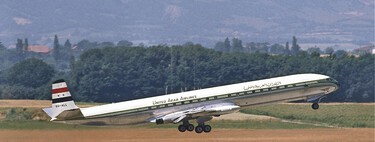The maneuver was not easy. Neither did his circumstances. In addition to entailing significant risk, those responsible had to meet the requirements of the Mexican authorities, deal with breakneck speeds, and meet deadlines that had almost expired. And yet, despite everything that could go wrong, the test that a group of scientists carried out in April 2012 in the desert of salty lagoonMexico, with a plane Boeing 727-200 it was a resounding success.
The reason? The ship crashed into the desert sand and was destroyed.
What we were saying: a complete success and absolute.
Although a long decade has passed, the XB-MNP experiment continues to stand out as one of the most spectacular chapters in aviation history. After all, it’s not every day that you see a Boeing lose altitude at breakneck speed until it ends up crashing in the middle of the desert, blown to pieces. Less common still is that the accident is caught 21 cameras and we can manage his balance of victims without feeling the slightest pity.
The reason is simple: the crash on that day in 2012 was not an accident, but rather an experiment to expand our knowledge of air accidents.
Objective: crash into the desert
If it was so surprising, it is largely because of who was behind it. As detailed in Flight Safety Foundationthe test was orchestrated for a television program made by Dragonfly Film and TV Productions hand in hand with other firms and which ended up being broadcast in the second season of the Curiosity series, from Discovery Channel. Not everything was a television show, however: the Boeing 727-200 was real, as was the impact and its previous preparation, traced to the millimeter to analyze the consequences of an accident among the passengers.
The scene in April 2012 was in fact the culmination, the closing minutes to a complex preparation work that had lasted for months.
For his experiment the Boeing 727-200 It was equipped with sensors, cameras and a dozen and a half dummies, a team of experienced technicians was selected to organize the controlled crash and the flight plan was designed to emulate two other recent accidents, the one involving January 2008 by a British Airways plane and in February 2009 during a Turkish Airlines flight
Perhaps the most complicated part of the operation—certainly the most expensive—was getting the plane. The team opted for a Boeing 727 for several reasons: its cabin and fuselage were similar to those of the Boeing 737a popular passenger ship, and featured a design that made it easy for the crew to parachute out of the ship at just the right time, before it crashed.
With that clear starting point, Discovery ended up taking over an old Boeing 727-200 that –precise simple flying— since the late 1970s he had flown for Singapore Airlines, Alaska Airlines and as a private charter, a long journey during which he had served, among others, the candidate Bob Dole during his Republican presidential campaign in 1996.
It may not have been a particularly new unit, but the people in charge of the study were able to buy it for a bargain price. At least for an aircraft destined for a kamikaze mission: approximately $450,000.
Once the material issues were resolved, another equally important task remained: finding professionals willing to participate in a test that -if it ended successfully- would end with a stamped boeing in the Baja California desert.
It may sound exaggerated, but the maneuver brought them. After the US vetoed the experiment being carried out in its territory, the team went to Mexico, where they had more luck. Of course, its authorities put certain conditions: it granted them a limited term and since the 727 would fly over inhabited areas, they demanded that during part of the test it operate with a pilot at the controls.
The one chosen for such a task was Captain Jim Bob Slocum, who would be in charge of managing the plane’s controls until almost the end of the experiment. At the decisive moment, before the crash, he would jump out of the ship with a parachute so that control would pass to Chip Shanleanother veteran former Navy pilot that would assume the operation remotely during the final minutes.
It remained to decide the “D-day” of the maneuver, a date that was set almost at the end of the term granted by the Mexican authorities. “We took until the 12th hour of the last day to get it”, would recount shortly after to the daily Los Angeles Times Dr. Tom Barth, a researcher and biomechanical engineer at the ntsb, the National Transportation Safety Board, one of the test scientists. It was agreed that that day would be April 27. for the crash Laguna Salada was chosenin Sonora.
And the day came.
The Boeing took off from Mexicali airport, in Baja California, with six people on board, including Bob Slocum. When the ship had traveled 60 miles —about 100 kilometers— the first officer and the flight engineer abandoned it and after 80 (130 km), with the plane already banked and just a few minutes of the clash in the Mexican desert they were joined by the captain himself. How did they leave the Boeing in midair? with parachute… and help from expert monitors.
Control of the aircraft then passed to Shanle, who remotely operated the aircraft to shut down the engines at the side of the fuselage and the tail engine to near idle. His goal, unusual for a pilot: crash.
Discovery’s cameras captured the key moment of the experiment well, when the Boeing’s nose hits the Laguna Salada desert, the front section breaks like a toothpick and the structure slides through the sand while losing different pieces, including the undercarriage. simple precise flying that at the moment of impact the ship was flying at 225km/h and it was descending at 460 m per minute, much more than in a normal landing.
What use was the experiment, beyond leaving an epic for the annals of television? Well, to collect data on what air accidents are like and, above all, what chances of survival the passenger has on board. The accident was in fact similar to the one in Iowa in July 1989 by a plane United Airlines I was flying from Denver to Chicago. Its tail engine failed and the ship ended up crashing, leaving a balance of 111 deaths and 185 survivors.
After examining the results, the experts concluded that in the Boeing 727 accident none of the passengers in row seven and above would have survived. Seat 7A, in fact —precise US Today— was shot at a distance of 152 meters. If it had been a real accident, the travelers located near the wings would have suffered some injuries and the best off would be those located at the rearthe one closest to the tail.
They were not the only conclusions they obtained. The interior cameras show the chaos generated inside the plane by hand luggage being thrown out of its compartments and confirmed the importance of using seat belts and correctly signaling emergency exits.
“You may think you know where it is, but suddenly you find yourself in the middle of a zero visibility dust cloud. Can you locate her?“, points to US Today John Hansmanteacher of Massachusetts Institute of Technology.
Interesting conclusions for an impressive experiment, worthy of the best Hollywood blockbuster and… Unique? Not at all. Discovery could have been inspired by a previous NASA experiment, which in December 1984 he ended up crashing his own well-fuelled Boeing 720 near the Mojave desert.
That, however, is another story.
Cover image: BriYYZ (Flickr)
In Xataka: The story of the Sea Shadow, the “stealthy” ship that wanted to be the US naval jewel and ended in a resounding fiasco









![[Img #74683]](https://thelatestnews.world/wp-content/uploads/2024/12/The-main-mistakes-to-avoid-when-betting-on-electronic-sports-150x150.jpg)




![[Img #74683]](https://thelatestnews.world/wp-content/uploads/2024/12/The-main-mistakes-to-avoid-when-betting-on-electronic-sports-300x200.jpg)
